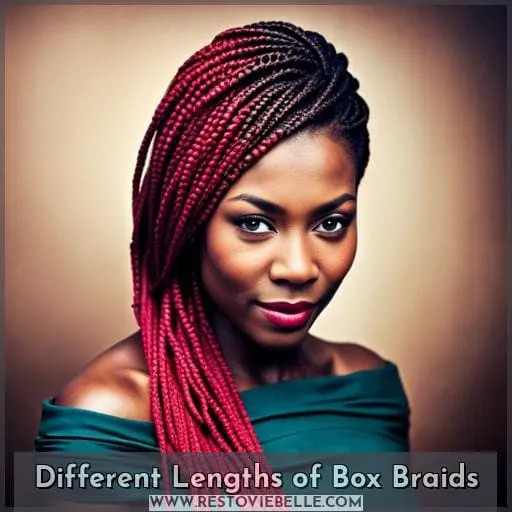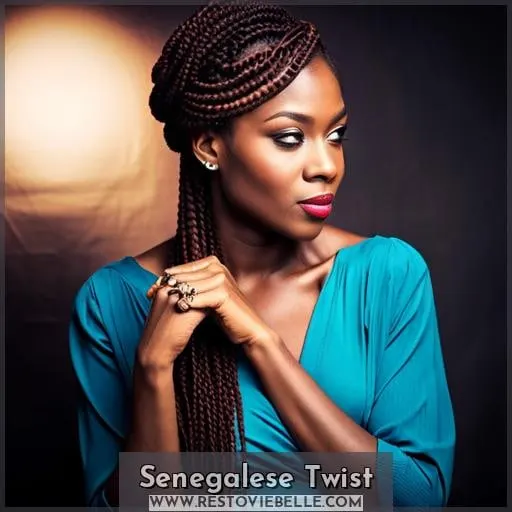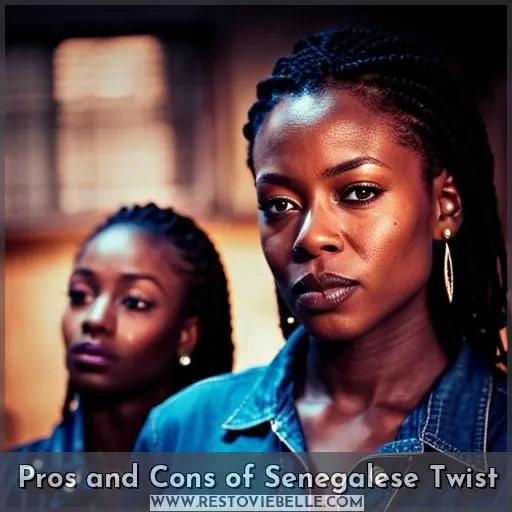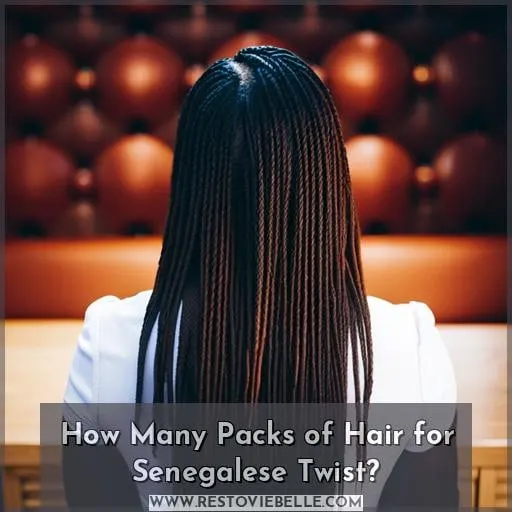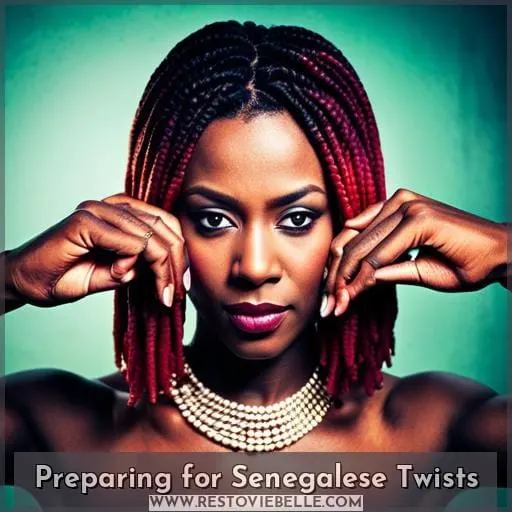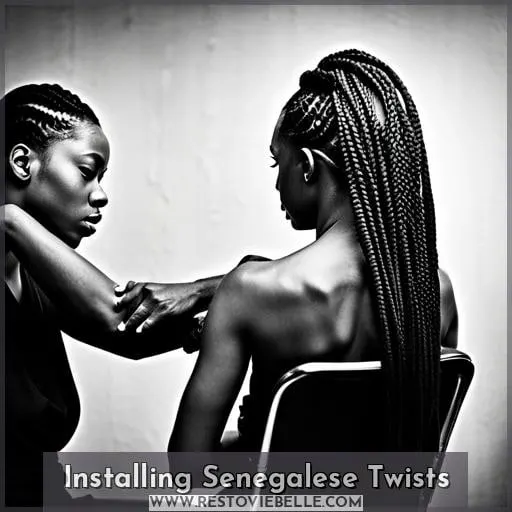This site is supported by our readers. We may earn a commission, at no cost to you, if you purchase through links.
 Are you thinking of getting box braids? Whether it’s for a special event or just to switch up your look, you’ll need the right amount of hair. But how many packs of hair do you need for box braids? It all depends on the size and thickness of your natural hair.
Are you thinking of getting box braids? Whether it’s for a special event or just to switch up your look, you’ll need the right amount of hair. But how many packs of hair do you need for box braids? It all depends on the size and thickness of your natural hair.
Generally speaking, 4-6 packs should be enough – but if you have thicker or coarser strands, it may take more than that.
We will also cover Senegalese Twist hairstyles and explain exactly what type and quantity of product is needed to achieve these looks.
So grab yourself some snacks – let’s get started!
Table Of Contents
- Key Takeaways
- Different Lengths of Box Braids
- How Many Packs of Hair for Box Braids?
- How Many Packs of Hair for Medium-Sized Box Braids?
- Senegalese Twist
- Pros and Cons of Senegalese Twist
- How Many Packs of Hair for Senegalese Twist?
- Preparing for Senegalese Twists
- Installing Senegalese Twists
- How Much Hair Should You Buy for Box Braids and Senegalese Twists?
- Conclusion
Key Takeaways
- Box braids generally require 4-6 packs of hair, but more may be needed for thicker hair.
- The number of packs needed for box braids can vary depending on the length and style.
- Kanekalon and X-Pressions are popular hair types for box braids, with different pack requirements.
- Regular maintenance is important for the longevity of box braids and other protective styles.
Different Lengths of Box Braids
No matter your style, you can create stunning box braids with long, short, and medium lengths to suit your preference. For a longer look, jumbo width hair is recommended for braid lengths of bob/shoulder length up to hip-length.
If you prefer a medium size braid, opt for large width hair from shoulder length up to hip-length or down depending on the desired effect.
To add more flair, try adding some crochet curly human or synthetic extensions at the ends of your box braids in goddess addition styles such as Boho Box Braids. For Marley twists and Havana twists, use 5 – 6 packs of Cuban or Marley Hair. Passion Twists require 9 packs of water wave crochet hair, while Spring Twists need 3 – 4 packs of spring twist hair.
Feed In Braiding needs 1 – 2 cornrows, then either 3 – 6 cornrows (medium), 7 – 10 (large), or twenty plus cornrows (jumbo).
Crochet Locs, Butterfly locs, and braided updos need six to eight single packs, while Faux Locs would take five– nine packs of Marleys. Soft loc also requires five Bobbi Boss Nu Locks and three water waves crochets. Fulani Lemonade styles should follow quantity recommendations too when making weaves, including curl type factor in mind.
With proper maintenance tips under scalp care, one could enjoy these beautiful protective hairstyles.
How Many Packs of Hair for Box Braids?
Jumpstart your braiding journey with the perfect amount of hair packs for box braids! Depending on the brand, style, and texture of hair used, quantity recommendations vary.
For instance, Kanekalon may require 8-10 packs, while X-Pressions needs 4-6. Jumbo width lengths such as Bob/Shoulder or Waist usually need 6-7 single packs. Large widths also require similar amounts but can go up to 9 if you want longer styles like Mid Back or Hip length.
Medium Width is typically around 5 single packets for Bob/Shoulder and 7+ for waist plus length hairstyles. If you are adding Goddess Boho curls on the ends, then 2 single packs should be enough.
Senegalese twists generally fall between 5 and 8 bundles (or sometimes 3 to 5). Marley twists require five to six packages of pre-stretched Cuban or Marley hair. Feed in Cornrows would need 1-2, 3-6, or 7-10 depending on how many rows desired.
Finally, Crochet locs, Butterfly Braids, etc., should use at least 6-8 singles per head when using synthetic straight curly human extensions.
How Many Packs of Hair for Medium-Sized Box Braids?
You’ll need 6-7 packs of hair to create beautiful medium-sized box braids. Depending on the brand used, you can purchase between 4 and 10 packs of hair for this style. For instance, Kanekalon may require 8-10 packs while Xpressions needs 4-6 and Bobbi Boss Nu Locs requires 5.
Here are some tips to achieve the perfect look:
- Choose a texture that matches your natural hair or desired style (curly, straight).
- Take into account factors like density and existing volume when selecting a quantity of extensions.
- Purchase slightly more than needed as it’s easier to work with extra than not enough!
- Use prestretched synthetic braiding hair for an easy installation process that won’t break off easily during styling.
Lastly, properly care for your hairstyle by shampooing regularly with light products designed specifically for extensions or protective styles such as Marley twists or faux locs which also require additional accessories if using human/synthetic curly varieties instead of regular straight braid types.
Senegalese Twist
Ready for a change of pace? Senegalese twists are an excellent choice for protective styling. This style is low-maintenance and offers hair protection while maintaining natural beauty.
With the right preparation, installing this look can be easy with 5-8 packs of Kanekalon or 3-5 bundles of human hair, depending on the desired length and fullness. To prepare your scalp and strands before starting, cleanse, shampoo, condition, and moisturize your hair thoroughly to avoid any damage during installation.
Parting your sections beforehand will also make it easier when twisting extensions into each part.
Compared to box braids, which require 6-7 packs depending on the brand used, Senegalese twists take more time but may be lighter than other styles like Marley Twists or Havana Twists, which need 5–6 packs per person, respectively.
So if you’re looking for a new hairdo that won’t break the bank yet still looks great, give Senegalese twists a try!
Pros and Cons of Senegalese Twist
Senegalese twists are a unique and stylish way to protect your hair while still allowing you to rock an interesting look. While they have many pros, such as being low-maintenance and protective of your natural locks, there are also some cons that come with this style.
These include the cost, time investment required for installation, and potential heaviness of the braids themselves. So if you’re looking into getting Senegalese twists done on yourself or someone else, it is important to consider these drawbacks before making a final decision.
Pros of Senegalese Twist
Senegalese twists offer several benefits, such as low maintenance and hair protection. They provide an easy way to switch up your look without needing to spend a lot of time or money on traditional box braids, which require multiple packs of hair.
Senegalese twists also offer more versatility in terms of style options than other hairstyles. They can be worn loose and wavy, pinned up into updos, or braided for a more formal look. Additionally, the cost is lower compared to box braids due to not needing nearly as much hair for installation.
Finally, these styles last longer than most others while still protecting natural strands from breakage. This is because the hair is in one big twist instead of many small ones like with usual box braid methods.
Cons of Senegalese Twist
Despite the benefits of Senegalese Twists, they can be time-consuming and costly to install. Maintenance is also more involved with these styles due to their tight coils, which require regular moisturizing and detangling.
There are variations available in this style, such as goddess locs or kinky twists. However, box braids remain a popular option for those seeking similar looks without the extra effort associated with caring for them.
Additionally, Senegalese Twist cost factors include purchasing between 5-8 packs of hair per installation. Usually, 3-5 bundles of human hair are needed if opting out from synthetic options. This makes Senegalese Twists significantly more expensive than other protective styling methods like Box Braids, which may only require 4-6 packs depending on the brand used.
How Many Packs of Hair for Senegalese Twist?
You’re likely to need 5-8 packs of hair for Senegalese twists, depending on the desired length and texture. When prepping your natural hair for this style, make sure to cleanse and condition it thoroughly.
For a full head of Senegalese twists, you may require up to 8 packs or 3-5 bundles of human hair extensions such as X-Pressions by Outre.
Additionally, protective styling can help extend their lifespan if maintained properly with regular deep conditioning treatments and moisturizing sprays in between washes.
Preparing for Senegalese Twists
Before starting your Senegalese twist hairstyle, it is important to prepare your hair for the style. To ensure a successful and long-lasting look, you need to make sure that your natural hair is clean and well-conditioned before braiding.
Cleaning includes using shampoo followed by conditioner, as this will help remove any dirt or product buildup from styling products such as gels or hairsprays. Additionally, moisturizing with water-based leave-in conditioners can provide extra nourishment for the scalp while also helping keep the twists hydrated throughout their wear time.
Keeping Your Hair Clean
To ensure your Senegalese twists look their best, it’s essential to keep your hair clean and healthy. Hair maintenance starts by washing the scalp with a mild shampoo and conditioner.
Afterwards, use a moisturizing product like shea butter or coconut oil for added hydration. To prevent breakage while styling crochet hair or jumbo box braids, spray on some natural leave-in conditioner before starting the process.
Before bedtime, cover up with a satin lined bonnet to retain moisture in the strands overnight so they last longer! Make sure you regularly massage your scalp when wearing braids as this promotes proper blood circulation, which is critical for healthy hair growth and retention of existing length over time!
Shampooing and Conditioning Your Hair
Before installing Senegalese twists, it’s important to properly cleanse and condition your hair for the best results. This usually requires around five to eight packs of human hair. The key is to choose the right products that are specifically designed for protective styles like braids and twists.
Start by shampooing your hair with a gentle cleanser as needed. Then, apply a moisturizing conditioner from root to tip before rinsing thoroughly. Afterward, towel dry or let your hair air dry naturally. Once your hair is dry, comb out any tangles using either your fingers or a wide-tooth comb.
Work through sections one at a time until all snarls have been removed without pulling on the strands too hard.
When you’re finished, use a leave-in conditioning spray or oil to keep your locks protected while styling them into box braids or other beautiful braiding techniques you desire.
Moisturizing Your Hair
Refresh your hair with a moisturizer for added shine and softness before styling box braids. To ensure proper hydration, look for leave-in conditioners that are specifically made to nourish kinky hair textures.
Products such as shampoos, natural oils, and creamy butters can work wonders in restoring moisture lost due to washing or exposure to the elements.
Utilize hydrating products from brands like SheaMoisture or Cantu daily; these will help protect your hair while wearing protective styles like box braids. Don’t forget about scalp care too! Use light massage techniques when applying product onto the scalp so that it gets fully absorbed into each strand of hair without leaving any residue behind, which could cause buildup over time if not properly cleaned out afterwards.
Installing Senegalese Twists
Once you’ve prepped your hair, installing Senegalese twists is a breeze – with the right technique and some patience, of course! Before getting started with this protective style, it’s important to understand both its pros and cons.
While these extensions offer low maintenance styling that can protect your natural locks from heat damage or breakage, installation requires time (and money) due to the large number of packs needed for full coverage.
When installing Senegalese twists, begin by parting and moisturizing the scalp. Then, twist extensions into each section along with natural strands until fully covered. If opting for box braids, more than 6-7 single packs may be required depending on the brand used.
For example, Kanekalon needs 8-10 packs, while Xpressions only needs 4-6 packs for medium-sized boxes to complete the look.
With proper care during wear, as well as the removal process when done enjoying the style, they’ll provide lasting beauty that you can enjoy again in the future!
How Much Hair Should You Buy for Box Braids and Senegalese Twists?
To get the perfect look for your Box Braids or Senegalese Twists, you’ll need to decide how much hair to buy. When it comes to box braids, Kanekalon hair usually requires 8-10 packs, whereas X-Pressions only needs 4-6 packs.
Meanwhile, Senegalese twists typically require 5-8 packs of human hair in total or 3–5 bundles per twist, depending on the desired length and thickness. Preparing for installation involves cleaning and conditioning your natural hair before moisturizing it.
Installing includes parting sections and twisting extensions with natural strands carefully.
For a Goddess Boho style addition like crochet curly ends or microtwists throughout the braid, look up to three single packs are necessary. On the other hand, a more intricate Marley/Havana/Kinky Twist will need at least 5–6 packs of Cuban/Marley Hair.
Faux locs may take from five to nine packages of Marley Hair, while Soft Locs would require Bobbi Boss Nu locs (3) plus Water Wave Crochet (2).
Fulani styles, as well as Lemonade Braided updo, may vary in quantity requirements, but weaves should not be done without factoring in their length, curl type, etc.
Conclusion
To sum it up, if you’re looking to get box braids or Senegalese twists, it pays to be prepared! You should know how much hair to buy for your style of choice, which is why it’s important to know the weight of the hair, the desired length, and the number of packs of hair required.
For box braids, it’s recommended to get 6-7 packs of hair, while Senegalese twists typically require 5-8 packs.
Preparing for Senegalese twists involves cleaning, shampooing, conditioning, and moisturizing your hair. When installing, make sure to part the hair, moisturize the scalp, and twist extensions with natural hair.
So, while you may be tempted to skimp on the hair packs, remember that a little extra won’t go amiss. After all, having enough hair for your box braids or Senegalese twists is the key to achieving the perfect style.
